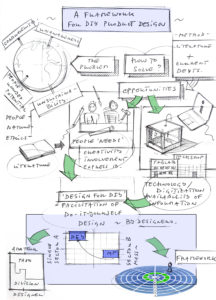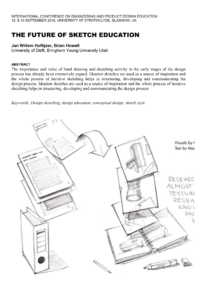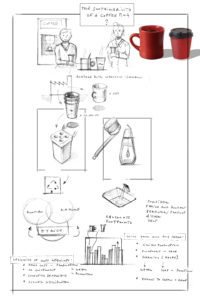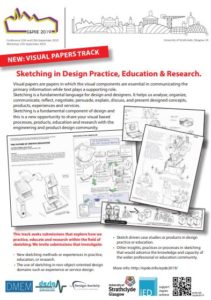We are pleased to announce a new visual papers track for E&PDE 2019.
Track Title: Sketching in Design Practice, Education & Research.
Sketching is a fundamental language for design and designers. It helps us analyse, organise, communicate, reflect, negotiate, persuade, explain, discuss, and present design concepts, products, experiences and services. It is used throughout a project’s lifecycle, from strategic initiation to tactical implementation. Sketching is a fundamental component of design, and new opportunities are needed to share visual based processes, products, education and research through peer-reviewed processes within the engineering and product design community.

This track seeks submissions that explore how we practice, educate and research within the field of sketching. We invite submissions that investigate:
- New sketching methods or experiences in practice, education, or research;
- The use of sketching in non-object-oriented design domains such as experience or service design;
- Sketch driven case studies or products in design practice or education;
- Other insights, practices or processes in sketching that would advance the knowledge and capacity of the wider professional or education community;
This track is inspired by the success of non-written and peer-reviewed outcomes from various contemporary technical and scientific conferences and publications such as CHI, DIS and Jove.com, a scientific video journal. It is also the direct result of the workshops held at Design Dubrovnik 2018 and E&PDE 2018 on visually driven academic output.
As this is the first year prototyping this type of output, accepted submissions will be included in the conference book of abstracts, the conference program and posted digitally as conference proceedings on the E&PDE website. However, they will not be printed in the physical conference proceedings book which limits papers in length, format and only to black and white.
This track will be trialled at E&PDE 2019, and if successful could become a permanent addition to the E&PDE conference in years to come.

What are Visual Papers?
Visual papers are papers in which the visual components are essential in communicating the primary information while the text plays a supporting role. Visual papers do not show design work only. Whatever is reported in a visual paper, it must have a research interest in the Engineering and Product Design Education (E&PDE) community. Visual papers are meant to contribute to new knowledge rather than document concepts, methods, and processes we already know.
Quality
In visual papers, production values and visual quality matters. We encourage authors to be thoughtful with their submissions and ensure the resolution of the images selected are of publication quality.
Review and Selection
For E&PDE 2019, visual papers will follow the standard double-blind peer review process that traditional papers follow. The review process is managed by the conference organisers and the visual paper chairs and associate chairs. Confidentiality of submissions is maintained throughout the review process.
Publication
To provide authors with more flexibility to accommodate colour, format and length in their papers, publications will be made in the visual paper proceedings on the E&PDE.info website only.
Call for papers download.
Format
All submissions should be submitted via the E&PDE ConfTool system. Please be thoughtful about your final document file size. It should not be excessively large.
Abstract
- Sketch your paper’s abstract on one A4 size paper. Use the E&PDE abstract template which is formatted in the vertical orientation (this format is required for printing in the conference abstract catalog).
- Text should be used in the title, along with keywords and short sentences. Text can also be used to support and inform the visual information but the abstract’s content should primarily be visually driven.
- The abstract should succinctly describe, using both words and sketches, the proposed papers content, purpose and impact.
- Authors names and references to institutions should be absent from the abstract to enable respectful double-blind reviews.
- Include references.
The reviewers should be able to easily understand the paper’s content to effectively judge its potential as a full-length visual paper and conference presentation.

Full Paper
With the acceptance of your visual abstract, you will be invited to submit a full paper and prepare a conference presentation. Given the visual character of the papers, specific criteria are as follows:
- Use the visual paper template provided on the E&PDE website. Being that the paper will be disseminated digitally on the epde.info website, and not physically printed, it can exceed the 6-page limitation that written texts are limited to. We expect contributions to be between 6 and 10 pages long, either vertically or horizontally formatted.
- Visual imagery should be of good quality and the primary form of communicating your narrative accompanied by text to support the imagery.
- A good visual paper requires precision and contextualisation in terms of evidence and detail in argumentation. It should consist of normal research issues: a research question and an outcome, a claim and an argument, and proper contextualisation through literature. Designs can be contributions to knowledge in and of themselves as a form of making, but they should be accompanied by a narrative that helps the audience understand what that knowledge contribution is.
Conference Presentation
As with the traditional papers, visual presentations will be limited to 20 minutes; 15 minutes to present and 5 minutes for discussion. Demonstrations, activities, audience participation, the use of whiteboards or wall space and adjusting the room layout (within reason) are acceptable components of a presentation.
Deadlines
Deadlines for visual papers will follow the same as paper submissions found here.
Visual Paper Chairs
Jan Willem Hoftijzer, Technical University of Delft
Bryan Howell, Brigham Young University
Associate Chairs
Jan Corremans, University of Antwerp
Dorothy Evans, University of Strathclyde
Jason Germany, University of Washington
Pepijn van Passel, University of Twente
Amos Scully, Rochester Institute of Technology
Paul Skaggs, Brigham Young University
Mark Sypesteyn, Technical University of Delft
Send questions or comments to:
Special thanks to William Odin and the Creators of the original 2014 DIS Pictorials Track and its recent revisions that has informed much of this track.

